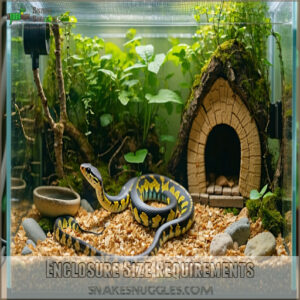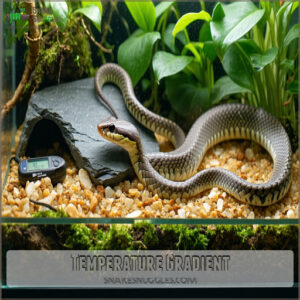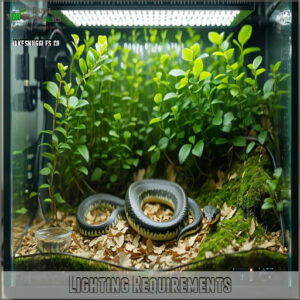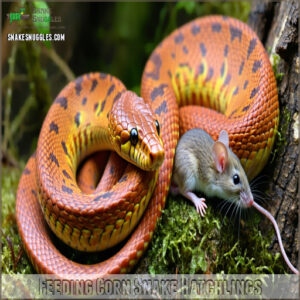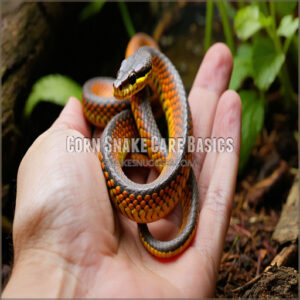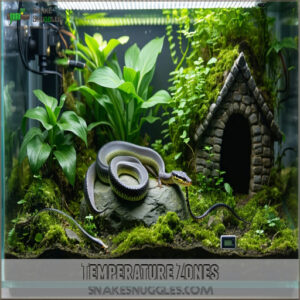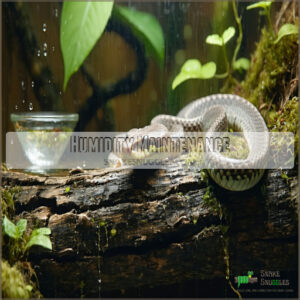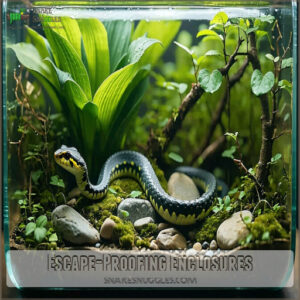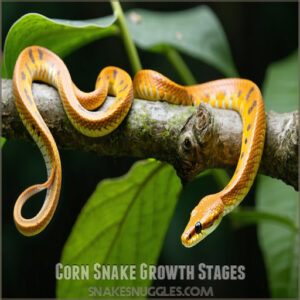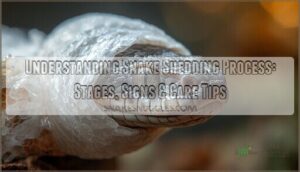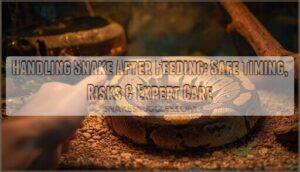This site is supported by our readers. We may earn a commission, at no cost to you, if you purchase through links.
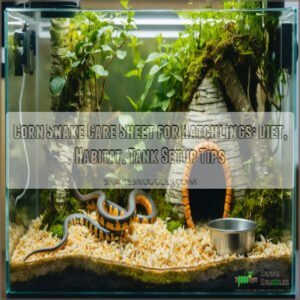
Line the tank with reptile carpet or aspen shavings about 2-3 inches deep – just like making the perfect snake nest. You’ll feed your little friend pinky mice every 5-7 days, but remember to use frozen-thawed prey for safety.
Keep handling sessions short and gentle at first, and always wash your hands. There’s nothing quite like watching your tiny serpent grow into a confident companion.
Table Of Contents
- Key Takeaways
- Corn Snake Housing Needs
- Feeding Corn Snake Hatchlings
- Corn Snake Care Basics
- Creating Ideal Environment
- Corn Snake Growth Stages
- Frequently Asked Questions (FAQs)
- What do newly hatched corn snakes eat?
- How to take care of baby corn snakes?
- How often should I feed my hatchling snake?
- How often do hatchling corn snakes typically shed?
- What color changes occur during hatchling development?
- When should I separate hatchling siblings?
- Can hatchlings recognize their regular caretaker?
- How long until hatchlings develop their adult pattern?
- Conclusion
Key Takeaways
- Set up a secure 10-gallon tank with a temperature gradient ranging from 75°F on the cool side to 89°F in the basking area, and keep humidity at 40-50%.
- Use a safe substrate like aspen shavings or reptile carpet, and provide hiding spots and climbing structures for comfort and activity.
- Feed frozen-thawed pinky mice every 5-7 days, ensuring prey size matches your snake’s girth, and offer fresh water daily.
- Handle gently with clean hands for short sessions, monitor shedding for stuck pieces, and regularly check for health issues like respiratory problems or mites.
Corn Snake Housing Needs
Setting up the right housing for your corn snake hatchling is simple but essential for its health.
You’ll need a secure enclosure with the right size, temperature, and substrate to keep your snake safe and comfortable.
Enclosure Size Requirements
Corn snake hatchlings only need a small setup at first. A 10-gallon tank is perfect, giving just enough space for movement without overwhelming your little snake.
You can find suitable corn snake hatchling tanks online.
Enclosure depth should accommodate the snake’s length, and make sure there’s good ventilation. A proper hatchling corn snake enclosure prevents escapes while meeting space needs, ensuring your snake feels secure and thrives in its environment with good ventilation.
Substrate Options
Picking the right corn snake substrate is key. For hatchlings, safe options include:
- Reptile Carpet: Reusable, easy to clean.
- Aspen Shavings: Perfect for burrowing, great for humidity control.
- Coconut Fiber: Retains moisture but might get dusty.
Avoid pine or cedar—they’re harmful.
Aspen shavings can cause health issues and should be avoided, learn more about proper substrate selection.
Lay substrate 2-3 inches thick to support natural behavior in your reptile vivarium.
Temperature Gradient
After setting up the substrate, focus on the temperature gradient. Corn snake hatchlings thrive with a basking spot at 85-89°F, while cooler areas can drop to around 75°F.
Proper corn snake housing requirements are essential for their health and well-being.
Use heat mats or ceramic heat sources to maintain control. Always monitor snake temperature with a thermostat to avoid overheating.
Skip UVB light—it’s unnecessary for these little guys.
Lighting Requirements
In regards to snake lighting, corn snakes don’t need UVB light like some reptiles.
Rather, focus on heat lamps or LED options to supplement their temperature gradient.
Natural light can help maintain a proper photoperiod, but artificial lighting works fine.
Just make certain the lighting requirements balance day and night cycles, keeping your corn snake’s setup comfortable and stress-free.
It is crucial to ensure the lighting setup supports a natural photoperiod.
Feeding Corn Snake Hatchlings
Feeding your corn snake hatchling is simple, as they primarily eat tiny frozen-thawed mice.
You’ll need to offer appropriately-sized prey once every 5-7 days to keep them healthy and growing.
Diet Composition
Planning your corn snake hatchling’s diet is straightforward. Newborn mice provide the perfect protein source and support nutrient balance.
For proper care, follow a detailed corn snake guide.
Stick to frozen-thawed options for safety and hygiene. Variety isn’t needed at this stage, but consistency matters.
- Use pinky-sized mice
- Verify prey is thawed properly
- Avoid live feeding
- Match prey to snake’s girth
- Fresh water daily
Feeding Frequency
A corn snake hatchling’s feeding schedule is pretty simple. Plan for one meal every 5-7 days.
Stick to this meal frequency to meet their nutrient needs without overfeeding. For a complete guide, review this corn snake feeding schedule.
Regularity helps establish healthy eating habits. Remember, their corn snake hatchling diet thrives on small, manageable portions, aligning with their size and energy needs.
Keep it consistent for a happy, healthy snake!
Prey Size Guidelines
When feeding your corn snake hatchling, prey selection is key.
Choose prey items that match the size of your snake’s girth to prevent choking or regurgitation.
Here’s how to match food size effectively:
- Newborns: Pinky mice
- 1-3 months: Fuzzy mice
- 3-6 months: Hoppers
- 6-12 months: Weaned mice
- Over 12 months: Small adult mice
Feeding Method
To keep your corn snake hatchling happy and healthy, offer pre-killed or frozen-thawed prey once a week.
Prey selection is key—choose food no wider than the snake’s girth. Stick to a consistent feeding schedule for better nutrient balance.
Fresh water quality is essential, so change it daily. This routine supports proper corn snake diet and growth.
Corn Snake Care Basics
Taking care of a corn snake hatchling means knowing how to handle them gently, maintain the right humidity, and watch for common health issues.
You’ll also need to stick to good hygiene practices to keep both you and your snake safe and healthy.
Handling Techniques
When handling corn snake hatchlings, use a gentle touch. Let them explore your hand to prevent snake wrapping or stress.
Start with short sessions and increase time as their temperament adjusts.
Handling tips include always washing your hands, lifting from the side, and avoiding quick movements.
Taming methods require patience and consistency for safe, calm snake handling experiences.
Humidity Levels
Humidity levels are essential for hatchling corn snake care, ensuring proper shedding and health. Aim for 40-50% humidity in their enclosure.
- Use a hygrometer for precise humidity control.
- Place a shallow water bowl in the tank.
- Add a moist hide with damp moss for shedding.
- Spray systems or fogging machines can help.
- Calibrate your hygrometer regularly for accuracy.
To maintain the desired humidity level, it is crucial to monitor and adjust the environment as necessary, ensuring the health and well-being of the corn snakes, which is directly tied to proper humidity control.
Health Issues
Corn snake hatchling health can face challenges like dysecdysis (trouble shedding) and pustular dermatitis (blister disease) from low humidity.
Watch for respiratory issues, scale rot, or mite infestations, which signal enclosure problems.
If your snake wheezes, refuses food, or shows skin changes, act quickly to address potential health issues, as respiratory issues can be a significant concern.
Regular checks and proper care can help avoid common corn snake hatchling problems and keep your snake healthy.
Hygiene Practices
Cleanliness matters for corn snake hatchling care. Wash hands before and after handling to protect both you and your snake.
Use proper cleaning supplies for tank maintenance, changing water daily and spot-cleaning waste promptly. Regular enclosure cleaning prevents bacteria buildup, supporting hatchling hygiene.
During snake shedding, watch for stuck pieces. Good sanitation keeps corn snake hatchling health in check and avoids diseases, which is crucial for corn snake hatchling care and overall hatchling hygiene.
Creating Ideal Environment
To keep your hatchling corn snake happy and healthy, you’ll need to create the right environment in its enclosure.
This means setting up proper temperature zones, maintaining humidity, providing hides and climbing spots.
Making the tank escape-proof is also essential to ensure your snake’s safety and well-being.
Temperature Zones
Set up temperature zones in your corn snake hatchling enclosure with a thermal gradient. Create a basking spot at 85-89°F using heat sources like mats or lamps.
Maintain ambient temperatures around 80°F, ensuring nighttime doesn’t drop below 70°F. Use reliable temperature control tools, like thermostats.
Proper temperature helps digestion and comfort. Always monitor with a thermometer for accuracy.
Humidity Maintenance
For corn snake hatchling humidity, aim for 40-50%.
Keep moisture levels consistent with a shallow water bowl in the enclosure.
For additional guidance, review ideal humidity ranges by species.
Use a hygrometer to monitor humidity control effectively.
Mist lightly if needed, or consider fogging systems for better control.
Too low? Poor shedding happens.
Remember, steady humidity is key for a healthy corn snake habitat and stress-free growth!
Hides and Climbing Structures
Hatchlings feel safer with places to hide and climb.
In your corn snake enclosure, include:
- Hide Boxes: Small cave systems or rock structures work great.
- Climbing Branches: Add sturdy tree roots or smooth branches.
- Snake Hides: Place one on the warmer and cooler ends. You can find a variety of corn snake hides online.
- Simple Decor: Use safe items to mimic their natural snake habitat.
Escape-Proofing Enclosures
During setup, you’ll want to make certain your snake enclosure is completely escape-proof. Even tiny hatchlings can squeeze through remarkably small gaps, so check every corner carefully.
Here’s what to focus on for foolproof snake escape prevention:
| Area | Common Issues | Prevention Tips |
|---|---|---|
| Lid | Loose clips | Use secure locking mechanisms |
| Corners | Tiny gaps | Apply silicone sealant |
| Ventilation | Wide mesh holes | Install fine mesh screens |
Remember, a determined corn snake can push against loose spots, so check all seals monthly to ensure your enclosure remains escape-proof and provides a safe environment for your corn snake.
Corn Snake Growth Stages
You’ll be amazed at how quickly your tiny corn snake hatchling grows from its initial 8-12 inches to an impressive adult length of 4-6 feet.
Your snake will reach its full adult size between 18-36 months, giving you plenty of time to adjust its habitat and care routine as it develops, allowing for a smooth adaptation to its new adult length.
Hatchling Development
From the moment they emerge, your tiny corn snake hatchling will measure just 8-12 inches and weigh 6-8 grams.
You’ll notice rapid growth patterns during the first few weeks, with weekly skin shedding as they develop.
Keep their tank at 90°F on the warm side and 75-82°F on the cool side.
Start handling gently after they’ve settled in, and offer their first meal – a small mouse – once weekly, focusing on a weekly routine.
Juvenile Growth
Your young snake will grow quickly during its juvenile phase, reaching 1-2 feet within the first year.
During this active growth period, you’ll notice more frequent shedding and increased appetite.
Feed your juvenile corn snake every 7-10 days, adjusting prey size as they grow.
Watch for their beautiful colors and patterns to develop – it’s like watching a living rainbow unfold before your eyes, a truly beautiful experience.
Adulthood Characteristics
Your corn snake’s journey to adulthood brings exciting changes in Adult Size and behavior. Understanding corn snake behavior patterns is essential for responsible ownership.
Once they reach maturity at 18-36 months, you’ll notice distinctive Growth Patterns as they stretch to 4-5.5 feet long.
Female snakes typically stay smaller than males. Their Snake Behavior becomes more predictable and calm, making handling easier.
Different Color Morphs display their full vibrancy in adulthood, with patterns becoming more defined and striking.
Lifespan Expectations
Your fully-grown snake companion can thrive for 20+ years with proper care, making them a long-term commitment. While wild snakes rarely reach their full potential, captive corn snakes often celebrate their 15th birthday and beyond.
Some exceptional individuals have even lived past 32 years.
Regular vet checks, proper nutrition, and maintaining ideal habitat conditions help maximize your snake’s lifespan.
Frequently Asked Questions (FAQs)
What do newly hatched corn snakes eat?
You’ll want to feed your newborn snake pinkie mice every 5-7 days. These tiny, frozen-thawed mice are perfect for your snake’s small size. Always make sure they’re properly thawed first.
How to take care of baby corn snakes?
Caring for hatchlings is like nurturing tiny scaley explorers.
Use a secure 10-gallon tank, keep it warm (80-85°F), and provide hiding spots.
Feed pinky mice weekly, and maintain 40-50% humidity.
Always offer fresh water.
How often should I feed my hatchling snake?
Feed your hatchling snake a newborn mouse every 5-7 days.
Make sure the mouse is about the same width as your snake’s body, thawed completely, and offer it in a calm, stress-free environment.
How often do hatchling corn snakes typically shed?
Hatchling corn snakes shed about every 4-6 weeks as they grow quickly.
Keep their humidity at 40-50% to support shedding.
A moist hide can help if you notice incomplete sheds or stuck pieces.
What color changes occur during hatchling development?
Hatchling corn snakes typically start with bright, bold patterns that gradually soften as they grow.
Colors become richer and more defined with each shed, often deepening to reveal vibrant shades and prominent markings over time, as the snakes mature and their appearance evolves.
When should I separate hatchling siblings?
Sibling separation shouldn’t stall—split hatchlings as soon as they’ve had their first feeding to avoid stress or aggression.
Small, separate enclosures help them thrive, offering space, safety, and less competition for warmth or food, which allows them to grow without the burden of excessive competition, thereby enhancing their overall development and well-being by providing a more peaceful environment, but most importantly, it is the safety that is crucial for their survival.
Can hatchlings recognize their regular caretaker?
Young corn snakes don’t recognize you like a dog might, but regular interaction builds familiarity.
They’ll get used to your scent, movements, and handling, making them more comfortable over time.
Consistency is key!
How long until hatchlings develop their adult pattern?
You might wonder when your snake starts looking like an adult.
Most hatchlings develop their mature color pattern by 12-18 months, though some keep subtle growth changes into their second or even third year.
Conclusion
Giving your corn snake hatchling the right care isn’t just a task—it’s the start of an incredible journey.
A proper habitat, steady temperatures, and regular feeding with pinky mice are all key to their health.
Use this corn snake care sheet for hatchlings to guide you in setting up their enclosure, managing their diet, and ensuring their growth.
With patience and love, you’ll raise a happy, healthy snake that thrives under your watchful eye, and have a successful experience in corn snake care.
- https://internetreptile.com/blogs/care-sheets/corn-snake-care-sheet
- https://reptile.guide/corn-snake-care/
- https://reptilesmagazine.com/corn-snake-care-sheet/
- https://www.thebiodude.com/blogs/reptile-and-amphibian-caresheets-with-cited-veterinary-and-herpetology-sources/care-guidelines-for-corn-snakes
- https://prf.hn/l/9OxmVxL

